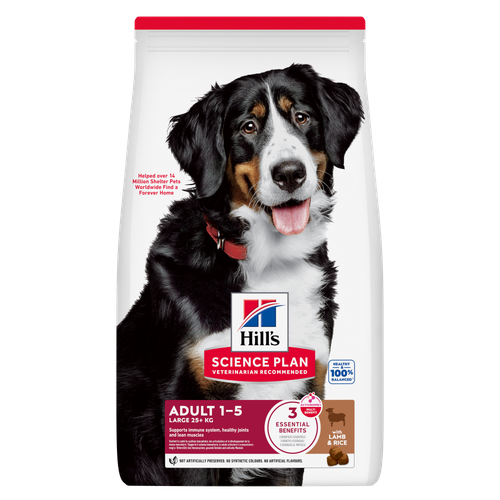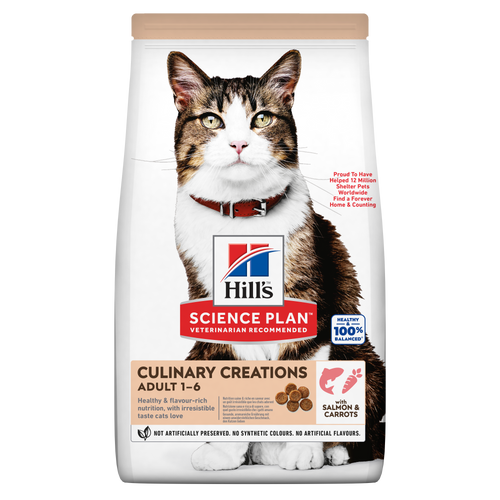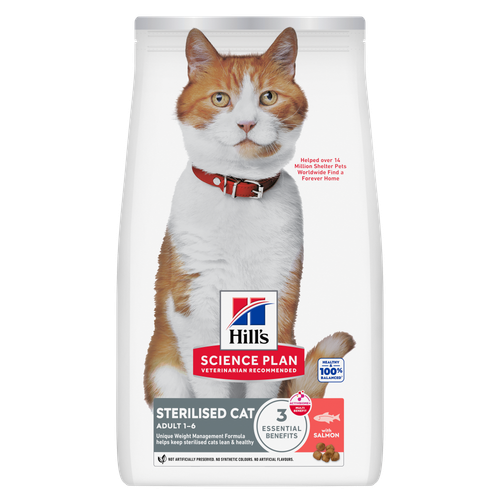
-
Find the right food for your petTake this quiz to see which food may be the best for your furry friend.Find the right food for your petTake this quiz to see which food may be the best for your furry friend.Featured products
 Large Breed Adult Dog Food
Large Breed Adult Dog FoodHill's Science Plan Large Breed Adult Dog Food with Lamb & Rice is a complete pet food, specially formulated with ActivBiome+ Multi-Benefit Technology.
This food is specifically designed to fuel the energy needs of large breed dogs during the prime of their life.Shop Now Adult Light Dog Food
Adult Light Dog FoodHill's Science Plan Light Adult Wet Dog Food is a complete premium pet food for adult dogs that tend to gain weight easily. This deliciously smooth loaf is formulated to deliver the appropriate amount of energy to support weight maintenance in adult dogs.
Shop Now Perfect Digestion Large Breed Puppy Food
Perfect Digestion Large Breed Puppy FoodPrecisely balanced nutrition with Hill's ActivBiome+ prebiotic blend actively contributes to supporting digestive health and overall wellbeing to help your pet feel their best
Shop NowFeatured products CULINARY CREATIONS ADULT CAT FOOD
CULINARY CREATIONS ADULT CAT FOODHill's Science Plan CULINARY CREATIONS Adult cat food with Salmon & Carrots was formulated to provide a great-tasting experience to cats. Its delicious flavour and texture are combine with essential nutrients to support cats' optimal health during the prime time of their life. Specially formulated with high-quality salmon protein, essential taurine for heart health & balanced minerals to support kidneys & bladder.
Shop Now Sterilised Adult Cat Food
Sterilised Adult Cat FoodHill's Science Plan Adult Sterilised Cat Dry Food with Salmon is specially formulated with ActivBiome+ Multi-Benefit Technology. It is a precisely balanced nutrition, tailored to meet the needs of sterilised cats, to help keep sthem lean & healthy.
Shop Now Adult Cat Food
Adult Cat FoodHill's Science Plan Adult Cat Food with Chicken is a complete pet food, specially formulated with ActivBiome+ Multi-Benefit Technology.
This food is specially formulated to fuel the energy needs of cats during the prime of their life.Shop Now -
Dog
- Dog Tips & Articles
-
Health Category
- Weight
- Food & Environmental Sensitivities
- Urinary
- Digestive
- Joint
- Kidney
-
Life Stage
- Puppy Nutrition
- Adult Nutrition
- Senior Nutrition
Cat- Cat Tips & Articles
-
Health Category
- Weight
- Skin & Food Sensitivities
- Urinary
- Digestive
- Kidney
-
Life Stage
- Kitten Nutrition
- Adult Nutrition
Featured articles Microchipping: The Facts | Hill's Pet
Microchipping: The Facts | Hill's PetThe government has announced that as of April 2016, all dogs in the UK must be microchipped by law.
Read More The Incredible Science Behind Your Pet's Microbiome
The Incredible Science Behind Your Pet's MicrobiomeLearn what your pet's microbiome is, how it contributes to your pet's gut and overall health, and why nutrition is important in maintaining healthy microbiomes.
Read More Pet Nutrition: What Makes "Healthy" Pet Food Healthy? | Hill's Pet
Pet Nutrition: What Makes "Healthy" Pet Food Healthy? | Hill's PetIn people, the right diet is very important. If you are eating the wrong way for your metabolism, activity level, age and lifestyle you could end up with health issues.
Read More -


Providing your cat with a happy lifestyle is what being a pet parent is all about, and it starts with her food. Along with plenty of fresh cool water, she needs the best cat food for her stage in life--one that includes protein, carbohydrates, certain types of fats, and essential vitamins and minerals to keep her active.
There are plenty of healthy cat food options on the market. But with so many products to choose from, where do you begin?
Meats vs. Meat Flavors
The first step to identifying the best cat food is to familiarize yourself with the products' ingredients. Keep in mind items are organized according to weight, PetMD points out, with the heaviest appearing first. You typically see the main meat product listed first or second because it has the highest weight (which includes water content).
If a pet food product in the US is labeled as having a single ingredient ("tuna," for instance), according to the Association of American Feed Control Officials (AAFCO), it must contain at least 95 percent of that food product. For products advertised as "with tuna", AAFCO requires that it only has to include 3 percent of that product. Tuna "flavored" on the other hand, means that there has to be enough so that a cat can discern the difference.
Once you start reading labels this closely, you'll notice common ingredients that appear in cat food, particularly the following items:
- Chicken, tuna, beef, corn, barley or wheat. Protein is important because it provides the necessary building blocks for muscle and contributes to energy your cat needs from her food.
- Wheat, corn, soy, barley, and oats. In addition to protein, animals use carbohydrates for energy.
Just like with our own foods, as you can see, it's important to know where the advertised food items appear on the ingredients list and why. Keep in mind, though, that a key ingredient may appear lower in the list because of its density, not for a lack of nutrition.
Common Vitamins
Along with proteins and carbohydrates, the best cat food has the vitamins that are essential to keeping a cat healthy.
- Vitamin A: typically in the form of beta-carotene, for healthy skin, vision, and immune system.
- B vitamins: including biotin (B7), riboflavin (B2), or pyridoxine (B6), niacin (B3), and thiamin (B1) for maintaining a strong nervous system and most vital organs. Thiamin is especially important in cats who are often predisposed to deficiency here.
- Folic Acid, or B9: a water-soluble vitamin that aids in digestion and promotes healthy cell growth, which is especially important for kittens and pregnant cats.
- Vitamin B12 supplement: also helpful for proper cell growth (both blood and nerve).
- Vitamins C and E, antioxidants that are crucial to the resilience of your cat's immune system.


Tasty Tips
Common Minerals
Minerals present in the best cat food aren't that dissimilar to those in your own nutritional needs. They include:
- Calcium, which keeps your cat's bones, joints, and teeth healthy.
- Phosphorous, obtained from the meat that cats ingest to build healthy teeth and bones alongside calcium.
- Iron, an element in mammal cells, used as a component of the hemoglobin in red blood cells. These are the cells that carry oxygen from the lungs to the rest of the body.
- Magnesium, important for all sorts of body processes, such as building strong bones, producing energy, and regulating blood pressure.
- Sodium, which maintains normal blood pressure as well.
- Zinc, needed to make the body's proteins as well as its DNA.
A healthy cat food will include these essential elements to provide your pet with a nutritious, well-balanced meal. Don't forget pet food ingredients are usually regulated by the product's home country's food and drug governing body, which should be of some additional comfort to pet parents.
Age and Weight
Your cat's nutritional needs change depending on circumstances such as age and weight, so speak with your veterinarian to determine which cat food is best. If you have a kitten, you know just how much energy she has. And because a kitten's body changes a lot during her first year; body weight will double or even triple in the first few weeks alone. She needs an abundance of nutrients for healthy living. These can be found in a food that's formulated especially for kittens: those that include nutrients such as DHA (found in fish oil) to aid brain and eye development, and folic acid to promote healthy cell growth.
Adult cats (ages one through six) and mature cats (ages seven through ten) should be fed according to their weight and level of activity. Cats who are eleven or older are considered senior pets, and their nutritional requirements reflect the changes that come with age. Key ingredients may include calcium to aid aging bones and joints, vitamins E and C to boost her immune system, or vegetable oil that contains omega fatty acids to keep her coat and skin soft and smooth. Work closely with your vet to determine which type of food will benefit your furry friend, and keep in mind that older cats tend to gain weight as their activity level decreases.
If she's overweight, she's not alone. In the US, 50% of cats are considered overweight or obese. The Telegraph reports one in four cats are considered obese in the UK, and it's not always due to old age. Cats become overweight when they consume more food than they work off with exercise. But before switching your cat's food to one specifically for weight loss, check with your vet to see if there is an underlying cause for the weight gain such as an illness or related health issue.
One of the first things you should do to revamp your feline's food is stop feeding her treats. Cats aren't too keen to "dieting," as you can imagine, but luckily there are foods to work with their metabolisms to make the transition easier.
Where to Buy
It's easy to get your cat a product that fills her bowl, but to be sure you're getting the best cat food for your furry friend, shop with your veterinarian or retailers that offer a wide variety to choose from. Whatever your preference, a good rule is to always buy your pet food products from your veterinarian, or a store and company you trust.
Whether you're a new or a seasoned cat parent, you and your furry friend will thrive from choosing the best cat food for her, one that will keep her healthy and active throughout her life.


Christine O'Brien is a writer, mom, and long-time cat parent whose two Russian Blues rule the house. Her work also appears in Care.com, What to Expect, and Fit Pregnancy, where she writes about pets, pregnancy, and family life. Find and follow her on Instagram and Twitter @brovelliobrien.
Related products

Hill's Science Plan CULINARY CREATIONS Adult cat food with Salmon & Carrots was formulated to provide a great-tasting experience to cats. Its delicious flavour and texture are combine with essential nutrients to support cats' optimal health during the prime time of their life. Specially formulated with high-quality salmon protein, essential taurine for heart health & balanced minerals to support kidneys & bladder.

Hill's Science Plan Adult Cat Food with Chicken is a complete pet food, specially formulated with ActivBiome+ Multi-Benefit Technology.
This food is specially formulated to fuel the energy needs of cats during the prime of their life.

Hill's Science Plan Adult Sterilised Cat Dry Food with Salmon is specially formulated with ActivBiome+ Multi-Benefit Technology. It is a precisely balanced nutrition, tailored to meet the needs of sterilised cats, to help keep sthem lean & healthy.

Hill's Science Plan Mature Adult Cat Food with Chicken is a complete pet food, specially formulated with ActivBiome+ Multi-Benefit Technology.
This food supports graceful aging in cats, providing a synergistic ingredient blend to help support energy & activity levels.
Related articles

Cats with sensitive skin have special needs and even healthy cats can sometimes develop poor skin health. Learn more about sensitive skin symptoms in your cat, what you can do to help your pet feel more comfortable and get recommendations on sensitive skin cat food.

Learn how your cat's poo can be a good indicator of her overall health, including how to spot unhealthy or abnormal cat poop and what it might mean.

Learn about the causes of cat dermatitis, how to spot the symptoms and the best treatment options. Visit Hill's Pet for detailed guidance and tips.

Understand common skin issues in cats and how to manage them effectively. Learn signs and prevention, and get care tips. Find out more at Hill's Pet.

Put your cat on a diet without them knowing
Our low calorie formula helps you control your cat's weight. It's packed with high-quality protein for building lean muscles, and made with purposeful ingredients for a flavourful, nutritious meal. Clinically proven antioxidants, Vitamin C+E, help promote a healthy immune system.
Put your cat on a diet without them knowing
Our low calorie formula helps you control your cat's weight. It's packed with high-quality protein for building lean muscles, and made with purposeful ingredients for a flavourful, nutritious meal. Clinically proven antioxidants, Vitamin C+E, help promote a healthy immune system.

